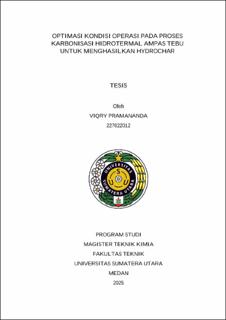| dc.description.abstract | Sugarcane bagasse is a type of biomass produced as a by-product of the sugarcane processing industry. The management of sugarcane bagasse can be carried out through hydrothermal carbonization to produce hydrochar. Optimization using Response Surface Methodology (RSM) can be applied to produce hydrochar from sugarcane bagasse with optimal characteristics. This study aims to: (1) optimize the operating conditions for the hydrothermal carbonization process of sugarcane bagasse to obtain hydrochar with optimal mass yield and higher heating value (HHV); and (2) analyze the characteristics of hydrochar produced under optimum operatiing conditions. The research involves designing the experiment, preparation of raw materials, hydrothermal carbonization, proximate analysis of hydrochar, statistical analysis, optimization and validation of optimum conditions, and characterization of hydrochar under optimum conditions. The operating conditions studied include operating temperature (180, 200, 220 °C), operating time (30, 60, 90 minutes), and biomass-to-water (BTW) ratio (1:8, 1:10, 1:12), using the Central Composite Design (CCD) approach. The optimum conditions for producing hydrochar with the best yield and HHV were determined to be at a temperature of 217.34 °C, a time of 9.6 minutes, and a BTW ratio of 1:6.64. Under these conditions, the hydrochar yield was 29.95%, with an HHV of 19.82 MJ/kg. The regression coefficient test results indicated that all independent variables significantly influenced the mathematical model developed for yield and HHV responses. Furthermore, residual assumption tests demonstrated that the mathematical model matched the experimental data. Proximate analysis revealed that the hydrochar contained 57.21% fixed carbon. Characterization using SEM-EDX confirmed a more uniform morphology in the hydrochar, featuring small pores and a carbon content of 39.27%. FTIR analysis identified several functional groups in the hydrochar. Characterization using SAA indicated that the hydrochar had a surface area of 1.0690 m²/g, a pore volume of 0.0021 cc/g, and a pore diameter of 3.680 nm, classifying it as a mesoporous material. The series of characterizations conducted validate the potential of hydrochar as a Solid Refuse-Derived Fuel (SRF) for co-firing in coal-fired power plants (PLTU). | en_US |


